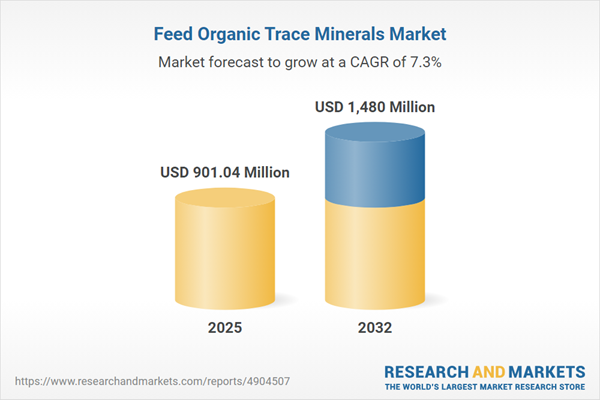Speak directly to the analyst to clarify any post sales queries you may have.
The feed organic trace minerals market is rapidly evolving as animal nutrition strategies increasingly value bioavailable, sustainable mineral sources. As feed producers adapt to new regulatory and performance expectations, this market is undergoing significant change driven by innovation and shifting demands.
Market Snapshot: Feed Organic Trace Minerals Market
The Feed Organic Trace Minerals Market grew from USD 843.83 million in 2024 to USD 901.04 million in 2025. It is expected to continue growing at a CAGR of 7.29%, reaching USD 1.48 billion by 2032.
Scope & Segmentation
This report offers a multidimensional analysis of the market, covering all major segments, technologies, and geographies supporting the adoption of organic trace minerals in animal nutrition strategies:
- Mineral Types: Chromium, Cobalt, Copper, Iodine, Iron, Manganese, Selenium, Zinc
- Chelation Chemistry: Amino acid chelates (Glycinate, Lysinate, Methioninate, Mixed Amino Acids), Encapsulated/Matrix-Protected, Methionine Hydroxy Analog Chelates, Organic acid salts (Citrate, Gluconate, Lactate, Propionate), Polysaccharide complexes (Plant- and Yeast-derived), Proteinates (Animal- and Plant-Protein Hydrolysate)
- Forms: Liquid, Powder
- Livestock Categories: Aquaculture (Freshwater fish: Carp, Tilapia; Marine fish: Salmon, Seabass; Shrimp & Crustaceans), Pets (Cats, Dogs), Poultry (Breeders, Broilers, Layers), Ruminants (Beef cattle, Dairy cattle, Goats, Sheep), Dairy, Swine (Boars, Growers, Sows, Weaners)
- Applications: Antioxidant & Stress Response, Bone & Skeletal Development, Egg Shell Strength, Feed Efficiency & Digestibility, Growth & Performance, Immunity & Health, Meat Quality, Milk Yield & Components, Reproduction & Fertility
- Distribution Channels: Offline, Online (eCommerce Website, Manufacturer Website)
- Regions Covered: Americas (North America: United States, Canada, Mexico; Latin America: Brazil, Argentina, Chile, Colombia, Peru), Europe, Middle East & Africa (Key European, Middle Eastern, and African markets), Asia-Pacific (China, India, Japan, Australia, South Korea, Indonesia, Thailand, Malaysia, Singapore, Taiwan)
- Featured Companies: Alltech, Zinpro, Novus International, Phibro Animal Health, Kemin, Evonik, BASF SE, Nutreco, Balchem, Biochem Zusatzstoffe, Cargill, Chemlock Nutrition, Dr. Paul Lohmann, DSM-Firmenich, EW Nutrition, Guangzhou Tanke Bio-tech, JH Biotech, Lallemand, Norel S.A., Olmix SA, Orffa, Purina, QualiTech, Vilofoss, Virbac S.A.
Key Takeaways for Senior Decision-Makers
- Organic trace minerals have shifted from niche to mainstream feed practices, aligning with sustainability and regulatory priorities across multiple regions and species segments.
- Technological innovation, including advanced chelation processes and precision formulations, empowers producers to target species-specific physiological outcomes and optimize feed conversion rates.
- Digital transformation is enabling greater supply chain oversight and real-time nutrition management, supporting efficiency and compliance objectives.
- Strategic partnerships and vertical integration among leading players enhance product quality, security of supply, and competitive differentiation.
- Regional regulatory differences and consumer expectations demand customized product portfolios and distribution models to succeed in diverse markets.
Tariff Impact and Supply Chain Strategies
Recent United States tariffs have introduced new cost structures, prompting feed manufacturers to diversify supplier bases and negotiate long-term contracts. Companies are pursuing domestic sourcing and engaging specialty chelation partners to secure critical inputs. Such measures, combined with ongoing cost-benefit analysis of mineral inclusion, help maintain performance and profitability in changing geopolitical contexts.
Methodology & Data Sources
The research integrates both primary data—expert interviews across the supply chain—and secondary evidence from reviewed journals, regulatory sources, and industry reports. Comprehensive data triangulation and segmentation analysis underpin robust, reliable findings that reflect real-world conditions across market dimensions.
Why This Report Matters
- Senior leaders gain clarity on real growth pathways, emerging risks, and actionable levers to optimize feed additive strategies for evolving stakeholder needs.
- The analysis delivers deep segmentation insights across animal type, mineral chemistry, and regional trends to guide targeted product development and investment decisions.
- Up-to-date coverage of tariffs, supply chain shifts, and innovation drivers ensures stakeholders are equipped for resilient, forward-looking market planning.
Conclusion
The feed organic trace minerals market is defined by innovation, adaptability, and diversified strategies. Decision-makers that leverage data-driven insights, strategic supply partnerships, and localized approaches will be well-positioned as the market continues to advance.
Additional Product Information:
- Purchase of this report includes 1 year online access with quarterly updates.
- This report can be updated on request. Please contact our Customer Experience team using the Ask a Question widget on our website.
Table of Contents
3. Executive Summary
4. Market Overview
7. Cumulative Impact of Artificial Intelligence 2025
Companies Mentioned
The companies profiled in this Feed Organic Trace Minerals market report include:- Alltech, Inc.
- Zinpro Corporation
- Novus International, Inc.
- Phibro Animal Health Corporation
- Kemin Industries, Inc.
- Evonik Industries AG
- BASF SE
- Nutreco N.V.
- Balchem Corporation
- Biochem Zusatzstoffe Handels- und Produktionsgesellschaft mbH
- Cargill, Incorporated
- Chemlock Nutrition
- Dr. Paul Lohmann GmbH & Co. KGaA
- DSM-Firmenich AG
- EW Nutrition GmbH
- Guangzhou Tanke Bio-tech Co., Ltd
- JH Biotech, Inc.
- Lallemand Inc.
- Norel S.A.
- Olmix SA
- Orffa Additives B.V.
- Purina Animal Nutrition LLC
- QualiTech, LLC
- Vilofoss A/S
- Virbac S.A.
Table Information
| Report Attribute | Details |
|---|---|
| No. of Pages | 185 |
| Published | November 2025 |
| Forecast Period | 2025 - 2032 |
| Estimated Market Value ( USD | $ 901.04 Million |
| Forecasted Market Value ( USD | $ 1480 Million |
| Compound Annual Growth Rate | 7.2% |
| Regions Covered | Global |
| No. of Companies Mentioned | 26 |









